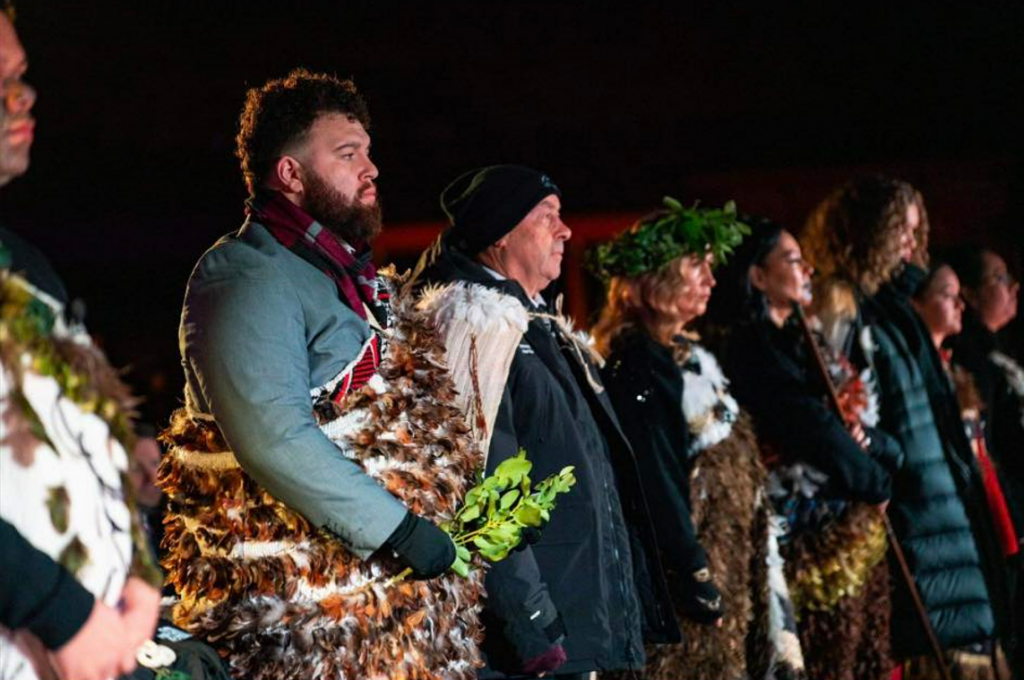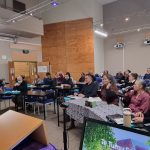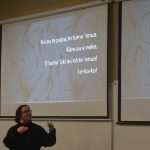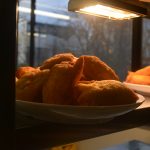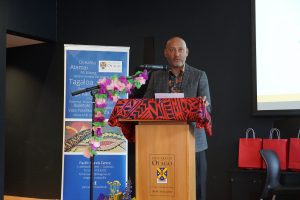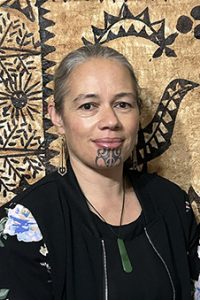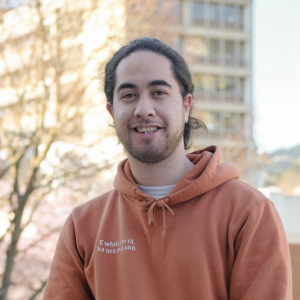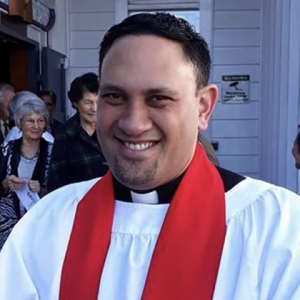Te Tumu scholar part of Kāhui Kairuruku the national Hautapu for Matariki
Ko Kare Tipa tōku ikoa, my ancestry comes from many hapū of Kāi Tahu iwi: (Kāti Ruahikihiki, Kāti Hāteatea,Kāi Te Aotaumarewa, Hinematua, Kāi Tuke, Kāti Huirapa, Kāti Rakiāmoa, Kāi Tuahuriri, Kāti Hinemihi, Kāti Wairaki, Kāti Urihia On Friday 28 June I was honoured to be part of the Kāhui Kairuruku, a collective of language and cultural practitioners that delivered 13 karakia as part of the national Hautapu ceremony held 2,008m above sea level, adjacent to the mighty ranges of Kā Tiritiri O Te Moana, on a pituresque mountain widely known as Treble Cone. Matariki allows us to reflect on whānau and experiences at a time when we welcome the new year. It is also a time to farewell the old, the past year gone.
It was appropriate to hold the hautapu ceremony in Wānaka. Māori history tells of Wānaka where early iwi, in particular ‘Waitaha’, assembled for learning of tribal lore. Wānaka is Kāi tahu alternative form of the word ‘wānanga’ referring to the ancient schools of learning. The area boasts of rocky alpines, tussock foliage and lakes dug out from the eponymous ancestor Rākaihautū. From the ski field on Treble Cone, one is able to feast eyes on the visible features of the land, the aesthetic appeal formed by the digging stick of Rākaihautū. Lakes dug out in Te Waipounamu are known as Kā Puna Karikari a Rākaihatū (the springs of water dug by Rākaihautū).
From ancestoral acts of the past to what is experienced today, Kāti Ruahikihiki descandants (the kairuruku for the hautapu) are made up primarily of young language assailants raised in the Kāi Tahu language revitalisation strategy: Kotahi Mano Kāika (KMK). KMK leads the charge to reinvigorate our language within Kāi Tahu homes and communities. It is a 25 year old strategy which aims to have at least 1000 Kāi Tahu kāika speaking te reo Māori by 2025.
As a practitioner, I have been both a beneficiary of and contributor to KMK. My children and grandson are part of the collective to revitalise and change the narrative with language normalisation here in Te Waipounamu. To be apart of the collective with our young adults is a tremendous highlight for me as a hākui in the strategy. The Hautapu ceremony is shared with a different iwi annually, this recent ceremony is historical for Kāi Tahu, it highlights the language strategy in action alive and vibrant, it sets a precedence of first language speakers who can conduct formal tikaka in te reo. I may not be here to stand with this collective when the Hautapu returns to Kāi Tahu iwi in the future, but I’m proud to have had this moment of standing with first language speakers adding to the histories of today.
Inaugural Te Tumu Symposium a showcase of diverse research excellence
On Wednesday 5 June, Te Tumu, School of Māori, Pacific and Indigenous Studies, hosted its inaugural research symposium to share and celebrate research from Te Tumu. The day began with a welcome from Te Tumu Dean Prof Patrick Vakaoti and a history of Te Tumu from Prof Michael Reilly. The programme included four sessions of Te Tumu staff and postgraduate students’ presentations, constructive question and answers segments, feedback, and encouragement.
Supported by Te Tumu’s Research Committee and Postgraduate Committee, the event welcomed attendance from those who are based in Ōtepoti, as well as distance students who are based in Te Whanganui ā Tara, and as far afield as New Caledonia. With special Tītī and fry bread kai, this gathering was truly an inspiring occasion and speaks to exciting research work that Te Tumu staff and students are doing locally, and regionally that are important contributions for their communities, and for the growth of Māori, Pacific and Indigenous Studies scholarship.
Session 1 was facilitated by Dr Paerau Warbrick, a lecturer in Māori Studies, and included presentations by Te Tumu staff member Paia Taani on intergenerational language transmission; and PhD students, Jenni Tupu who presented about transracial adoption, and Ella Cameron-Smith who presented on Ngaati Korokii Kahukura kai identities.
Session 2 was facilitated by Dr Telesia Kalavite, a lecturer in Pacific Studies, and included presentations by four PhD students: Frédéric Dichtel who presented on te reo grammatical structures; Regina Maniam who presented on engaging Indigenous values and methods in doctoral research; Stacey Kokaua-Balfour who presented on Cook Islands’ creative texts relating to the environment and climate change; and Jay Quintos who presented on critical perspectives on films about the Tboli people in the Philippines.
Session 3 was facilitated by Prof Michael Reilly, the Postgraduate Chair of Te Tumu. The session included staff member Prof Richard Jackson who presented on non-violent approaches to counterterrorism, and two PhD students: Jude Bautista who presented on visual social semiotics and critical lenses in discourse analyses; Kim Cope Tait who presented on personal sovereignty in the poetry of Hinemoana Baker.
Session 4 was facilitated by Dr Emma Powell, lecturer in Indigenous Studies and Programme Coordinator of the Master of Indigenous Studies (MIndS). The session included three MIndS distance students: Melissa Denzler, based in Te Whanganui ā Tara who presented on the cultural taxation of kaiako Māori; Elizabeth Hamilton, based in Whakatū, who presented on a approach for honouring Te Tiriti specifically relating to language learning policies for migrants and former refugees; and James Uri-Puati, based in the Cook Islands, who presented on a critical Indigenous framework for theorising second language learning.
Niue texts researcher signs MOU with Tāoga Niue

Last week, Dr Jess Pasisi (Mutalau, Hikutavake, Niue; Ngāti Pikiao, Tahiti) signed a Memorandum of Understanding (MOU) alongside Moira Enetama, Director of Tāoga Niue, Ministry of Social Services, of the Government of Niue. The MOU relates to Dr Pasisi’s Marsden […]
Te Hiringa o te pao
Inātata nei, i rarau atu kā kaimanako o te reo ki tētahi hui taumata ki Te Kura o Ōruapaeroa, Ōtautahi 23-24 Māehe 2024. Ko Terea Te Waka te hui taumata e kōrero nā, he mea whakatū e Te Pae Motuhake o Te Tai Toka. He mea tautoko hoki tēnei hui e Te Mātāwai hai whakaohooho, hai whakaaweawe i kā reaka o nāianei kia tika te kawe i kā ōhākī tuku iho, kia whakairohia te anamata mō ā tātau tamariki mokopuna.
Nā ko tētahi o kā kaikōrero matua o te hui nā, ko Kare Tipa. He kaiako ia ki Ōtākou Whakaihu Waka, waihoki, koni atu i te kahuru tau ia e whakaako ana ki kā Kura Reo. He taiwahine a Kare i pakeke mai i Te Tai o Araiteuru, i raro hoki i āna mauka kōrero. Ko Moeraki ake te papamoe ō ōna tīpuna, heoi, nō te tokorima taotao o Tahu tou tēnei īnati.
Kaupapa Kōrero: Te Hirika o te pao!
Ko tā Kare he hāpai, he whakatinana, he whakatauria i te reo me ōna tikaka. I te nuika o te wā kai ruka i te horopaki o ‘Te tū o te wahine nō Kāi Tahu’. I tō Kare whai i te reo, ko KMK hoki tētahi puna reo i whai waahi atu a Kare i roto i kā tau. Ko tōhona takeka pūkeka, kai kā mahi a Rukutia, arā ko kā mahi tito ko kā wānaka reo me kā wānanka tikaka Māori, otirā, kai te tuhia hoki tana tuhika kairaki. Nō nākuanei a Kare kua whakahaere wānaka hai whakapakari i kā pūkeka wāhine, pūkeka karaka, pūkeka pao, pūkeka mōteatea hoki, tae atu ki ētahi tikaka mahika kai.
PacTNet panel discussion & Pacific Voices Alumni celebration
On 27 November 2023, 20 years of the University of Otago’s Pacific Voices Postgraduate Symposium was celebrated with alumni, staff and current Pacific students at the Auahi Ora space in the Student Union Building. The evening programme began with an address from Tofilau Nina Kirifi-Alai, past manager of the Pacific Islands Centre and current Pacific Community Engagement Manager in Auckland. Tofilau shared reflections on establishing the symposium after seeing the need for postgraduate support in 2002 and gave encouraging words for organisers and students taking the symposium forward.
Her opening remarks were followed by an address from Deputy Vice Chancellor, Research & Enterprise, Professor Richard Blaikie who commented on Pacific research within the context of the University’s strategic direction. He enthusiastically supported Tofilau’s opening remarks and later engaged openly with the audience during the Q&A session at the end of the evening.
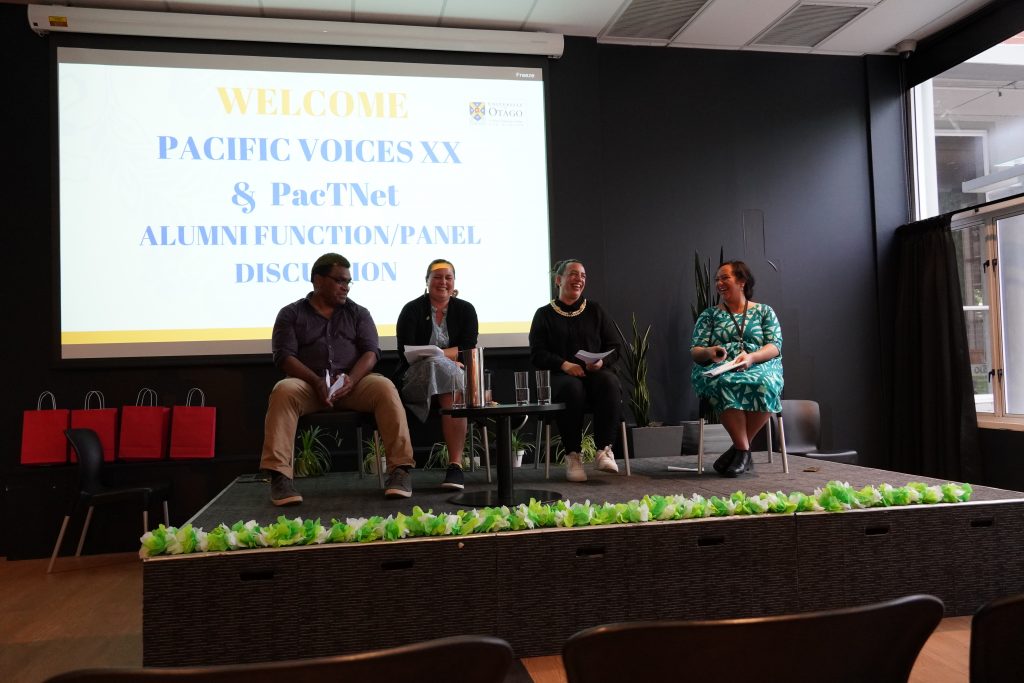
Panelists L-R Dr Tui Rakuita (Sociology), Dr Jess Pasisi (Te Tumu), Professor Rose Richards (Acting Director, Pacific Development Office & Co-Director of Coastal People, Southern Skies) and facilitator Dr Emma Powell (Te Tumu).
As a part of the programme, the symposium organisers and staff from the Pacific Development Office teamed up with the Pacific Thought Network (PacTNet) to arrange a public panel discussion. Earlier this year in May, PacTNet held its inaugural Pacific Lecture which was given by Tootooleaava Dr Fanaafi Aiono Le-Tagaloa and the panel gathered key Pacific thinkers from our university community to reflect on the ideas and comments made in the lecture. The panellists were Professor Rose Richards (Acting Director, Pacific Development Office & Co-Director of Coastal People, Southern Skies), Dr Tui Rakuita from Sociology and our very own, Dr Jess Pasisi. All of the panellists gave stimulating thoughts on Tootooleaava’s lecture, ranging from comment on Pacific leadership at the University of Otago, the significance of the diaspora to Pacific thinking, and the romanticism with which we hold Indigenous knowledge.
The PacTNet steering committee is made up of a number of our Te Tumu staff: Professor Patrick Vakaoti, Dr Telesia Kalavite and Dr Emma Powell. They are also joined by Dr Allamanda Fa‘atoese who is based in Christchurch and Dr Charles Radclyffe from Archaeology.
A number of our Te Tumu students participated and presented on their research during the Pacific Voices Symposium XX which was held on the following day, Tuesday 28 November 2023. For photos and coverage, check out the story from Pacific Communications Advisor, Keilah Vaetoru Fox, here.
MAI hui-ā-tau hosted by Te Kunenga ki Pūrehuroa, Massey University in Palmerston North
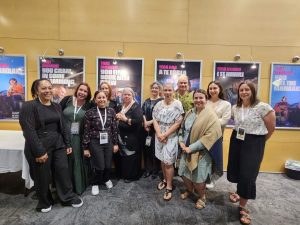
MAI ki Otago contingent at MAI hui ā-tau ki Te Kunenga ki Pūrehuroa, Massey University in Pamerston North.
Tokowhā ngā tauira Tohu Kairangi o Te Tumu e haere ana. Te rawe hoki o ngā kōrero me te whakawhanaungatanga i puta ai i reira. Kei runga noa atu te manaakitanga o ngā kaiwhakahaere nō reira, ngā mihi maioha ki a rātou. E rere hoki ana ngā mihi ki Te Kura Rangahau Tāura, ki a Rachel Sizemore kōrua ko Inano Walter i ā kōrua manaaki i a mātou, ko MAI ki Otago.
This year the annual MAI conference was hosted by Te Kunenga ki Pūrehuroa, Massey University in at the Palmerston North campus. Four PhD students from Te Tumu attended the hui. The presentations and networking opportunities were awesome. The hospitality of our hosts was amazing which we all appreciated. We also thank The Graduate Research School especially Rachel Sizemore and Inano Walter for supporting and looking after the MAI ki Otago group.
Highlighting research: Teachers of mainstream curricula, teaching Māori speaking children
Earlier this year Paia Taani, one of Te Tumu’s staff members published an article based on the research undertaken for her master’s degree which investigated teacher preparedness to teach te reo Māori speaking children in mainstream primary schools. Some of her key findings included an awareness of how language and culture impact on identity and educational outcomes. Although participants acknowledged the absolute necessity that te reo Māori and tikanga Māori are included in all aspects of the education setting, they also reported that tikanga Māori is a more comfortable space to be in than te reo Māori as there were clear connections to their own values.
Four key themes emerged from the findings which Paia promotes in the article as key factors for teacher readiness to teach reo Māori speaking children. These are: Kia rite (be prepared), Kia hono (be connected); Kia tātatiako (be culturally competent and responsive) and, Kia whakauruuru (be integrative). This article discusses those four factors listed above and implications for tamariki, their whānau, teachers and ITE providers. You can find the link to her article here, published in the New Zealand Journal of Teachers’ Work, June 2023.
https://ojs.aut.ac.nz/teachers-work/article/view/362
Paia will be presenting on this kaupapa next week, at the New Zealand Association for Research in Education Conference in Palmerston North.
First PhD oral examination held at Ōtākou Marae
E tino poho kererū ana ngā tāngata o Te Tumu ki a Megan Pōtiki. He pūkenga o mua a Megan, ā, ko tētahi o ā mātou tauira tohu kairangi. I tērā wiki, ka tū te whakamātautau o tāna tuhinga kairangi ki tōna marae, i Ōtākou. Koinei te whakamātautau kairangi tuatahi ki tētahi marae o tēnei rohe. Ko “Te Hū o Moho” te ingoa o tāna tuhinga e whakamāramatia nei ngā take i mate ai te reo Māori ki te kāika o Ōtākou i te haurua tuatahi o te rua tekau o ngā rautau. Ko Paerau Warbrick rāua ko Lachy Paterson ngā kaiārahi mō ngā mahi rangahau nei a Megan. I te hui hoki tōna whānau rātou ko ōna hoa. I reira hoki a Jacinta Ruru (ko te kaiwhakarite o te whakamātautau) rātou ko ngā kaiwhakawā tokorua, ko Tony Ballantyne rāua ko Peter Meihana (nō Te Kunenga ki Pūrehuroa). Pai rawa atu te kōrero whakamārama a Megan, me āna whakahoki i ngā pātai a ngā kaiwhakawā. Ka mutu ngā pātai a Tony rāua ko Peter, ka matapakitia āna rangahau e ērā atu tāngata o te hui. He tikanga rerekē tēnei, ā, ka whakaaetia e te katoa he tikanga pai, ā, ka whakamahia pea mō ngā whakamātautau kairangi katoa. Heoi, ka whakatau ngā kaiwhakawā, he rawe te tuhinga a Megan. Kia whakatikatia he hapa pakupaku, ka oti āna mahi. He rongo tino pai tēnei. He nunui hoki ā mātou mihi ki ngā tāngata whenua o Ōtākou mō te pai o te pōwhiri, me te reka hoki o te hākari.

Megan Pōtiki pictured here with her whānau, and kaitautoko from the University of Otago at Ōtākou Marae.
Staff at Te Tumu are extremely proud of Megan Pōtiki. She was a former lecturer, and has been one of our PhD students. Last week, the examination of her doctoral thesis was held at her marae, at Ōtākou. This is the first doctoral examination on a marae of this region. Her thesis is entitled “Te Hū o Moho” in which she explained the causes of the death of the Māori language in her village of Ōtākou in the first half of the twentieth century. Paerau Warbrick and Lachy Paterson were the supervisors of her research work. Her friends and family were also at the hui. There too were Jacinta Ruru (the examination convenor) and two of the examiners, Tony Ballantyne and Peter Meihana (Massey University). Megan gave an excellent presentation, as were her answers to the examiners’ questions. When they had concluded their questions, other people at the hui then discussed her research. This was a departure from normal process, and everyone agreed it was a great tikanga that might be used for all doctoral examinations. The examiners determined that Megan’s thesis was excellent, and when she tidies a few typos, she will be finished. This is great news. We would also like to thank the local people at Ōtākou for their warm welcome, and the wonderful food.
Te hiranga o te ao kapa haka
To celebrate Te Wiki o te Reo Māori, the Te Tumu Research Committee is showcasing the exceptional work of Māori postgraduate students writing their theses in te reo. Roma Donaldson-Gush talked to Maioha Watson, and asked him to share some insights about his rangahau.
Kia kaha te reo Māori te kaupapa matua o tēnei wiki. Hei whakamana i tō tātou reo Māori, kua kōrero atu a Roma Donalson-Gush ki ētahi o ngā tauira Māori e tuhi ana i ā rātou ake tuhinga roa (Tohu Paerua, Tohu Kairangi rānei) i te reo Māori. Ia rā o te wiki nei, ka whakaatu ai tētahi o aua tauira, i tēnei rā, ko Maioha Watson tērā.
Ko te kaupapa o tōna tuhingaroa, he whakakīkī haere i te puna rangahau e hīnātore ai te hiranga o te ao kapa haka ki te ao whānui, inarā, i ōna hua maha ki te hunga rangatahi. Ko te ngako, he matapaki i ngā wheako o te hunga rangatahi kātahi anō ka whakaeke atu ai ki te papa tātāwhāinga o Te Matatini; me te aha, he whakatairanga i ōna kura huna ki te ao.
Nā te aha koe i whiriwhiri i tēnei huarahi ki te tuhi i tō tuhinga whakapae i roto i te reo Māori?
“Nōku e matapaki, e whāwhā ana i te puna o te kī, me uaua ka kitea ngā hua o te ao haka ki te hunga rangatahi, me te mea hoki, he kaha tonu nō te ao pūtaiao Pākehā ki te whakahāwea i ō tātou mātauranga Māori. Nā konā i toka ai te whakatau, me tuhi taku tuhinga whakapae i te reo Māori. Hei āpitihanga, ko tāku e tōngakingaki nei ko te whakamāori i te kōrerotia o te reo Māori, kia maringi, kia tangata whenua, kia noho ko tōku reo ake, hei reo mātāmua mōku.”
He aha ngā āhuatanga matua, ngā hua me kī, kua puta i tō kōwhiringa ki te tuhi i roto i te reo Māori?
“Ko te ako, ko te whakawhānui ake i ōku mōhiotanga ki tōku ao. I te mutunga iho, ko tāku he whakahoki i ōku wheako, i ngā mātauranga kua akona e au ki tōku iwi, hei oranga mōna.”
He kupu tohutohu, he kupu akiaki rānei āu mō ngā tauira e hiahia ana ki te whai rangahau i roto i te reo Māori?
“Ākina, kōrerotia te reo! Kaua e kōrapa, e ngāueue ki te tuku i tō reo kia rere. Whakanuia, whakarangatirahia tā tātou taonga, tō tātou reo kāmehameha, ki te ngutu o te makiu.”
Te kapa haka me te Atuatanga
To celebrate Te Wiki o te Reo Māori, Te Tumu Research Committee is showcasing the exceptional work of Māori postgraduate students writing their theses in te reo Māori. Roma Donaldson-Gush talked to Te Hira Paenga, and asked him to share some insights about his rangahau.
Kia kaha te reo Māori te kaupapa matua o tēnei wiki. Hei whakamana i tō tātou reo Māori, kua kōrero atu a Roma Donalson-Gush ki ētahi o ngā tauira Māori e tuhi ana i ā rātou ake tuhinga roa (Tohu Paerua, Tohu Kairangi rānei) i te reo Māori. Ia rā o te wiki nei, ka whakaatu ai tētahi o aua tauira, i tēnei rā, ko Te Hira Paenga tērā.
He tauira a Te Hira nō Te Tumu me te Mātai Whakapono Karaitiana. Ko te whāinga o tōna rangahau, he whakaū i te kaupapa Māori, otirā te mātauranga Māori, ki roto i ngā kaupapa Atuatanga. Mā te tūhura, mā te tāutu, mā te arotake i ngā ihoatua o te ao kapa haka e whai hononga ai tēnei wānanga a te Māori ki te Atuatanga. Ko tōna urupounamu, he aha ngā ihoatua e kitea ana i roto i ngā mahi kapa haka kei ngā tuhinga, kei ngā whakaritenga rangi me ngā oro waiata, me ngā nekeneke ā-tinana? Ka mutu, he aha ōna kura puaki e kīia ai tēnei rangahau Atuatanga he ihoatua whakahirahira a te Māori?
Nā te aha koe i whiriwhiri i tēnei huarahi ki te tuhi i tō tuhinga whakapae i roto i te reo Māori?
“Ko te tuatahi tēnei o ngā tuhingaroa Atuatanga i te ao kua tuhia ki te reo kāmehameha, arā ki te reo Māori. Kua roa te iwi Māori e tito haka ana, waiata ana, mōteatea ana, hīmene ana, aha atu, aha atu. Kua tae ki te wā e ōkawa ai ngā kaupapa Atuatanga kua roa e noho waiwai ana i roto i te iwi Māori. He ākonga kura kaupapa Māori ahau i puta i Hoani Waititi i te tau 2000, nā reira, ko te reo o aku tīpuna e āki ana i a au kia Māori te kupu, ā, kia Māori te kawe.”
He aha ngā āhuatanga matua, ngā hua me kī, kua puta i tō kōwhiringa ki te tuhi i roto i te reo Māori?
“Ko te tūmanako ka whāia tonutia ngā tuhinga Atuatanga reo Māori e ngāi pīkoko, otirā e te rangatahi hei ngā rangi e tū mai nei.”
He kupu tohutohu, he kupu akiaki rānei āu mō ngā tauira e hiahia ana ki te whai rangahau i roto i te reo Māori?
“Kia kaha rā, ahatia te kaupapa, te horopaki, te matū rānei o ngā kaupapa tuhi, ā, kia kounga te reo. Torotoro ki te hunga e matatau ana i te reo, ā, whai hononga ki ētahi mātanga kua tohunga nei ki ngā mahi e rangahautia ana e koe. I te korenga o ngā tuhinga kairangi Pūtaiao, Pāngarau, Mātai Hinengaro, Pūoro, Atuatanga, aha atu, aha atu, kua noho ko te reo me te ahurea Māori hei mātāmuri ki ngā kaupapa auraki. Kua tae ki te wā e whakaohooho ai te taniwha mātauranga Māori, reo Māori, kua roa e moe ana i te rua o mahara. Kia hiwa ake Māori mā, nō koutou te ao!”

